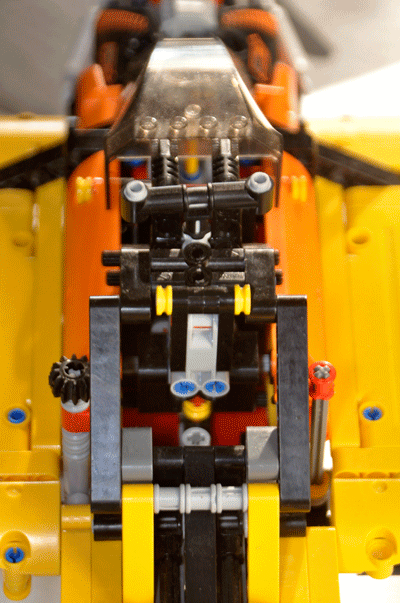HELIX DESIGN
The helix is a standard 3 blades 120º design centered in an axle. The blades are secured by a little 2u beam (1X2 W/Cross And Hole) that fixes it to a doubled Technic Lever unit (3X120) acting as a centre support. This configuration ensures that no blade cannot be ejected by the centrifugal force.
The front end is decorative and can be eventually replaced by a conical shaped element.


RETRACTABLE UNDERCARRIAGE
The model has a damped undercarriage that retracts under the wings. The retracting mechanism is manually driven by a gear under the battery box.
The system has been designed to support the airplane weight avoiding the flexing movements and minimizing the number of parts. In order to support the weight, high strength dampers must be used.
DESIGN CRITERIA
For realistic purposes the helix is driven by a standard Power Functions motor fed by an AAA battery box (4x11x7) . The rotation speed of such a motor is usually too low to be realistic. So there is a gear system that increases the rotation speed. You can operate the little on/off switch in the battery pushing the flight instruments panel support in the cockpit. You can open the cockpit canopy to reach it.
Of course the security criteria in the project has been considered. The helix is made in a special design avoiding that the centrifugal force produces the loss of a blade. On the other hand, the gear system uses a friction gear avoiding any possible personal damages in the event of touching the rotating helix. This system protects the motor too.
The model has a damped undercarriage that retracts under the wings. The retracting mechanism is manually driven by a gear under the battery box.
Due to the lack of non specular beams with bows (panels), some design licences have been taken. The rudder is made with symmetrical panels and the elevator is mono-block without horizontal stabilizer.

CONTROL STICK
In order to help the handgrip handling, the controls are positioned outside the cockpit and are not at the same airplane scale. This may seem a little confusing but lets the user an easiest manipulation of controls that would be impossible otherwise.
Moving the control stick to left and right produces an ailerons movement up and down and you get the roll control. Moving the control stick forward and backward forces the elevator movement and you can control the pitch.
Of course the control stick can be freely moved around its center position enabling the ailerons/elevator control as in a real airplane.
To left and right from the control stick you can see the spoiler control and the flap control respectively.



